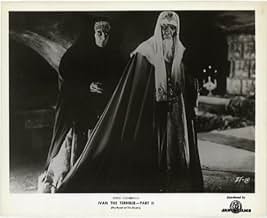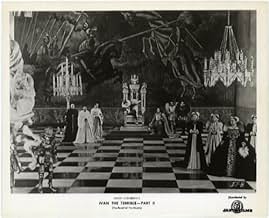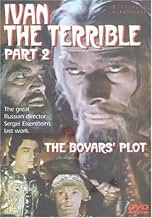IMDb रेटिंग
7.7/10
8.5 हज़ार
आपकी रेटिंग
अपनी भाषा में प्लॉट जोड़ेंAs Ivan the Terrible attempts to consolidate his power by establishing a personal army, his political rivals, the Russian boyars, plot to assassinate their Tsar.As Ivan the Terrible attempts to consolidate his power by establishing a personal army, his political rivals, the Russian boyars, plot to assassinate their Tsar.As Ivan the Terrible attempts to consolidate his power by establishing a personal army, his political rivals, the Russian boyars, plot to assassinate their Tsar.
- निर्देशक
- लेखक
- स्टार
- पुरस्कार
- कुल 1 नामांकन
Vsevolod Pudovkin
- Nikolay the Fanatic
- (as V.I. Pudovkin)
Ada Voytsik
- Elena Glinskaya, Ivan's Mother
- (as Ada Vojtsik)
Aleksandr Rumnev
- The Stranger
- (बिना क्रेडिट के)
Semyon Timoshenko
- Kaspar von Oldenbock, Livonian ambassador
- (बिना क्रेडिट के)
फ़ीचर्ड समीक्षाएं
It's great art.Eisenstein can be compared to Michelangelo,no less.Needless to say,you've got to see part one -slightly inferior to this one,but what does it mean,when you' re watching the seventh art at the height of its terrible powers?-.This part focuses on the feud between Ivan and his aunt who tries to replace him by an effeminate imposter of her choice.Prokofiev music gives the feeling of watching an opera,the scenes in the cathedral recreate a mystery as it was in the Middle Ages as faithfully as you can wish.The peak of the movie remains the banquet,shot in color,thanks to spoils of war film.So stunning is Eisenstein's mastery of the picture that you can hardly exactly tell when the color returns to black and white (which for the final becomes a color in itself)Ivan's last soliloquy might seem aggressive and chauvinistic.But you've got to remember that the USSR were at war at the time ."Ivan" is timeless ,a monument that's as awesome today as it was for its -deleted,because of Stalin- 1958 release.
In 1564, Ivan, The Terrible (Nicolai Cherkasov), is feeling alone: his wife, friend and great companion was poisoned and his best friend, Prince Andreu Kurbsky (Mikhail Nazvanov) has betrayed him and delivered some Russian cities to Poland. Trying to have somebody to believe, he promotes Archbishop Philip (Andrei Abrikosov) to the highest authority of the church in the city of Moscow. Then, the story presents lot of treason in his court and a great revenge. This movie is so remarkable as `Part I' is. The photography, lights and shadows in black and white are again a piece of art. There are at least twenty minutes in color, and in my opinion t would be better off being only in black and white. The sumptuous scenarios are amazing, plenty of details and very luxury, and the story is a sequel of an epic. The direction and the performance of the cast are outstanding, making this movie another unforgettable masterpiece and highly recommended. However, it is necessary to watch the `Part I' first, otherwise the viewer will not understand the story. My vote is ten.
Ivan the Terrible marks the final stages of the cinema's greatest creative genius: SERGI EISENSTEIN. It is the work of a director, a supreme artist who never ceased in probing new boundires, striking out uncharted paths, and searching the outer limits of his art. In the work, Eisenstein has gone eons beyond his earlier methods of film creation and for the first time approaches a true synthesis of dance, music, poetry, painting, photography, architecture, and all other forms of aesthetic communication.
The trials and tribulations surrounding the production and distribution of Ivan have become legendary in there own right. The film drew sharp criticism from Stalin and Eisenstein was forced to publicly announce his ''formalist errors.'' Subsequently, the film was banned in Russia until 1958 and Eisenstein was ostracized for what many saw as a film full of ''excess.'' It took many years before the world would come to realize it is nothing short of his greatest masterpiece.
A true cinematic realization of the ever elusive ''total work of art.'' A concept that originated with the Ancient Greeks and was further formulated by Richard Wagner in his epic masterwork, ''THE RING CYCLE.'' The Gestanmueack or ''intragel work of art'' as Wagner called it was in essence the synthesizing of every artistic medium into a single polyphonic experience. In the 20th century Eisenstein saw Wagner's music dramas as predecessors of cinema; a cinema that synthesized elements of all of mankind's arts into a single majestic, visceral and emotional experience which could transform and transfix the spectator. Together with the world renowned composer, master Sergei Prokofiev, and his lifelong cinematographer Eduard Tisse, Eisenstein labored for years researching and planning out every camera angle, lighting scheme, musical note, costume, color palette, gesture, and perspective; until every scene in Ivan becomes an intricate and complex world of its own. A world where actors twist and bend their forms to the limits of the plastic frame, shadows conceal and light reveals, the musical notes flow with the rhythm and tempo of the visual image and in the famous banquet scene, colors are used by Eisenstein to delve into the psychological states of the character's mind and state of being. It becomes a universe composed so precisely and diligently that every frame is infused with hidden metaphorical and symbolic meanings, and serves to create the epitome of cinematic achievement.
Tragically, like Schubert's great ''Unfinished Symphony'' or the Venus di Milo, Eisenstein passed away before completing the final part of his epic masterwork. What remains of Ivan the Terrible will live forever as a testament not only to the genius of Sergei Eisenstein but also to his unparalleled contribution to the world culture of the 20th century.
The trials and tribulations surrounding the production and distribution of Ivan have become legendary in there own right. The film drew sharp criticism from Stalin and Eisenstein was forced to publicly announce his ''formalist errors.'' Subsequently, the film was banned in Russia until 1958 and Eisenstein was ostracized for what many saw as a film full of ''excess.'' It took many years before the world would come to realize it is nothing short of his greatest masterpiece.
A true cinematic realization of the ever elusive ''total work of art.'' A concept that originated with the Ancient Greeks and was further formulated by Richard Wagner in his epic masterwork, ''THE RING CYCLE.'' The Gestanmueack or ''intragel work of art'' as Wagner called it was in essence the synthesizing of every artistic medium into a single polyphonic experience. In the 20th century Eisenstein saw Wagner's music dramas as predecessors of cinema; a cinema that synthesized elements of all of mankind's arts into a single majestic, visceral and emotional experience which could transform and transfix the spectator. Together with the world renowned composer, master Sergei Prokofiev, and his lifelong cinematographer Eduard Tisse, Eisenstein labored for years researching and planning out every camera angle, lighting scheme, musical note, costume, color palette, gesture, and perspective; until every scene in Ivan becomes an intricate and complex world of its own. A world where actors twist and bend their forms to the limits of the plastic frame, shadows conceal and light reveals, the musical notes flow with the rhythm and tempo of the visual image and in the famous banquet scene, colors are used by Eisenstein to delve into the psychological states of the character's mind and state of being. It becomes a universe composed so precisely and diligently that every frame is infused with hidden metaphorical and symbolic meanings, and serves to create the epitome of cinematic achievement.
Tragically, like Schubert's great ''Unfinished Symphony'' or the Venus di Milo, Eisenstein passed away before completing the final part of his epic masterwork. What remains of Ivan the Terrible will live forever as a testament not only to the genius of Sergei Eisenstein but also to his unparalleled contribution to the world culture of the 20th century.
Ivan Grosnyy, Part II is the movie of my life; the Part I is also a very good film. It is the masterpiece of Sergei Eisenstein. Unfortunately we can never see the Part III of this meant to be trilogy. The performances (especially Nikolai Cherkasov), the photography, the wardrobe, the scenarios and the shots are the most beautiful I have ever seen in the history of film-making. However, it is necessary to watch the Part I first to understand the history. I suggest to all the people who like this genre of film to see another very good film of Sergey Eisenstein: Alexander Nevsky once again with Nikolai Cherkasov in the main role. I recommend to all the people who want to see these movies to by the Criterion DVD box set, which contains also first part and, Alexander Nevsky. Don't die without seeing these masterpieces.
10rnair
This space can't afford me the kind of gargantuan platform needed to speak on Eisenstein's masterwork (both parts) with the sort of attention to detail and passion that the director brings to the story of the Russian tsar. This is the rarest of films that stands as a testament to how cinema can extend beyond an entertainment and exist as a singular work of art and a document that works to expand our knowledge of the human condition. Every frame is rich, every scene speaks far more than any written line or action. The production is a phenomenal achievement in the absolute totality of the collaborative effort; the actors, the set, the cinematography, the soundtrack - every facet of the film-making process has worked to create a seamless connection. While the approach of the actors, the lighting and the choices of camera angles frustrate our standard ideas of what a movie should look and feel like, there is a design here; it is precise and it is brilliant. This is a film for those viewers who, as Eisenstein famously said, read (not just watched) the images on the screen. One of the two or three true masterworks in the history of movies.
क्या आपको पता है
- ट्रिवियाThis film was withheld by Soviet authorities by order of Joseph Stalin, since this film, dealing with Ivan's slide into madness and the tyranny of the Oprichnina, did not properly mythologize Ivan IV Grozny to Stalin's satisfaction. It was not finally released until 10 years after the deaths of director Sergei Eisenstein and Stalin.
- गूफ़In the movie young Ivan IV is making a contract with the Livonian Brothers of the Sword. However it didn't exist since the 7th June 1238, almost 300 years before Ivan was born.
- भाव
Czar Ivan IV: From now on I will become the one you call me. I will become terrible.
- क्रेज़ी क्रेडिटThe main cast and their roles is read by the narrator with accompanied footage.
- कनेक्शनFeatured in The Secret Life of Sergei Eisenstein (1987)
टॉप पसंद
रेटिंग देने के लिए साइन-इन करें और वैयक्तिकृत सुझावों के लिए वॉचलिस्ट करें
विवरण
- रिलीज़ की तारीख़
- कंट्री ऑफ़ ओरिजिन
- भाषा
- इस रूप में भी जाना जाता है
- Ivan the Terrible, Part II: The Boyars' Plot
- फ़िल्माने की जगहें
- उत्पादन कंपनियां
- IMDbPro पर और कंपनी क्रेडिट देखें
बॉक्स ऑफ़िस
- दुनिया भर में सकल
- $1,655
- चलने की अवधि
- 1 घं 28 मि(88 min)
- रंग
- ध्वनि मिश्रण
- पक्ष अनुपात
- 1.37 : 1
इस पेज में योगदान दें
किसी बदलाव का सुझाव दें या अनुपलब्ध कॉन्टेंट जोड़ें

































